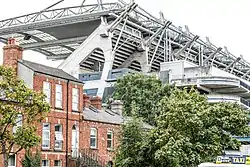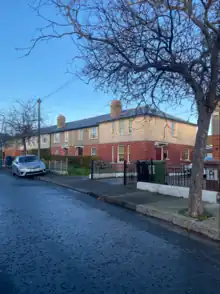Clonliffe
Clonliffe (Irish: Cluain Life) is an area on the Northside of Dublin, Ireland, between Ballybough and Drumcondra in the Dublin 3 postal district.
Clonliffe
Cluain Life | |
|---|---|
Inner city neighbourhood | |
 Croke Park seen behind Victorian townhouses on Jones's Road, Clonliffe | |
| Country | Ireland |
| Province | Leinster |
| County | Dublin |
| Local authority | Dublin City Council |
| Time zone | UTC+0 (WET) |
| • Summer (DST) | UTC-1 (IST (WEST)) |
Location
Clonliffe Road, previously known as Fortick's Lane,[1] is a wide thoroughfare that forms the central artery of the area. It is nearly a mile in length. Near the area's border with Drumcondra there is an entrance to Holy Cross College, and to the grounds of the residence of the Archbishop of Dublin. The main access to Croke Park GAA sports ground is from Jones Road, the principal turn-off on the south side of Clonliffe Road.
The historical area of Clonliffe was bounded by the River Tolka, down to the North Circular Road (possibly as far South as Aldborough House).[2]
History
Clonliffe as a named townland is mentioned in 1192, and the name is thought to mean "herb meadow"[3] or from "the plain of the Liffey" in reference to the River Liffey.[2] Clonliffe Road was originally known as Fortick's Lane, named for the previous owner of Clonliffe House, Tristram Fortick,[1] a saddle-maker who began leasing the property from John Graham (an Alderman from Drogheda) on a 94-year lease in March 1710.[4] Clonliffe House, also known as the Red House, is the earliest extant building in the area. Frederick Jones moved into the House and renamed the house and the road Clonliffe. The house was described in a poem by Thomas Caulfield Irwin:[2]
"There was a long, old road anear the town,
Skirted with trees:
One end joined a great highway; one led down
To open shores and seas.
There was no house on it save only one
Built years ago:
Dark foliage thickly blinded from the sun
Its casements low"[2]
At the corner of Clonliffe Road and Ballybough Road, there is an area which was historically used as a burial place for those who died by suicide. Criminals were also buried at this plot, and historian Eamonn Mac Thomáis states that the bodies of the highwayman, Larry Clinch, and his gang were displayed there after their execution.[5]

In the mid-19th century, it was proposed that a university be located at Clonliffe.[6] In 1854, Holy Cross College (also known as Clonliffe College) was founded as the Dublin diocesan seminary for Dublin by Cardinal Paul Cullen (1803-1878).[7] The grounds of Clonliffe College form a large portion of the area today. The college is adjacent to the residence of the Archbishop of Dublin, which is located just North of Croke Park Stadium.[8]
Clonliffe Harriers is an athletics club based in Morton Stadium.[9]
Under the Drumcondra, Clonliffe, and Glasnevin Township Act 1878, it became part of the township of Drumcondra, Clonliffe and Glasnevin, within County Dublin. The area was absorbed into the city of Dublin in 1900.[10][11]
Donnelly's Orchard

Donnelly's Orchard was a small housing scheme that Dublin Corporation undertook in 1923. Their intention was for this development to be finished in time to qualify for the Million Pound Grant. This area was a 12-acre plot on the banks of the River Tolka, previously used for allotments. Trustees seemed to be happy for this space to be used for housing, when the use of this space for allotments had ceased. Dublin Corporation's own housing department was too busy to undertake this project at this time, so the Corporation asked Messrs McDonnell and Dixon to undertake the task. The houses planned to be built were cottages, containing a parlour, living room, three bedrooms, a scullery and indoor sanitary facilities. Although, not everyone in the council agreed and in the meeting in April 1923 there was a proposal for smaller houses to be built so the people associated with the Corporation would be able to afford the rent. In 1933, the development was built to the size it stands today. 10 four-roomed cottages and 138 three-roomed cottages were built. During the same time, baths and hot water systems were installed in the previous housing developments in the area. The 1938 Ordnance Survey Plan displays the completed scheme, which includes the same design elements that are present in Drumcondra today; such as cul-de-sacs and short terraces with substantial garden space front and rear of the house.[12]
References
- Hopkins, Frank (5 November 2009). "Big Wind Too Great A Trial For 'Big Tree'". Irish Independent. Retrieved 16 November 2022.
- Cosgrave, Dillon (1904). "Clonliffe". The Journal of the Royal Society of Antiquaries of Ireland. 34 (4): 361–364. ISSN 0035-9106. JSTOR 25507393.
- M'Cready, C. T. (1987). Dublin street names dated and explained. Blackrock, Co. Dublin: Carraig. p. 23. ISBN 1-85068-005-1. OCLC 263974843.
- Registry of Deeds, Dublin. Memorial: 6-172-1707. "A Memoriall of Indenture of Lease bearing date the Second day of December One Thousand Seven Hundred and Ten made and perfected between John Graham of the Towne of Drogheda, Alderman of the one part and Tristram Fortick of the City of Dublin, Sadler of the other part... All that and those the Great House of the Grange of Clonliffe with all the out houses, walls, coveniencys and appurtenances thereunto belonging or in anywise appertaining And also all that piece or parcell of land thereunto next adjoyning comonly known by the name of part of the Grange Land containing from the outside of the mearing gripe of the said land all round to the river nine acres be the same more or less... fronting the New Avenew intended to be made by the said Fortick before the said Great House... To hold to him the said Tristram Fortick, his executors, administrators and assignes from the Twenty Fifth of March last past for Ninety Four yeares at and under the yearly rent of Thirty Six pounds sterling..."
- "Ballybough and the mysterious 'Suicide Plot'". Come Here To Me!. 19 March 2018. Retrieved 16 November 2022.
- "1864 – Proposed University of Ireland, Clonliffe, Dublin". Archiseek - Irish Architecture. 5 February 2010. Retrieved 31 January 2022.
- Cardinal Paul Cullen, Multitext Irish History project Archived 12 October 2008 at the Wayback Machine www.ucc.ie website
- "HOLY CROSS COLLEGE". DUBLIN STREET IMAGES. Retrieved 28 November 2022.
- "Official site of Clonliffe Harriers". Retrieved 28 November 2022.
- McManus, Ruth (2002). Dublin, 1910–1940: shaping the city & suburbs. Four Courts. p. 313. ISBN 9781851827121.
- Dublin Corporation Act 1900, [63 & 64 Vict., Ch. cclxiv]
- Brady, Joseph (2021). Building healthy homes: Dublin Corporation's first housing schemes 1880-1925. Ruth McManus, Dublin. City Council. Dublin. pp. 233–235. ISBN 978-0-9500512-6-0. OCLC 1224246136.
{{cite book}}: CS1 maint: location missing publisher (link)